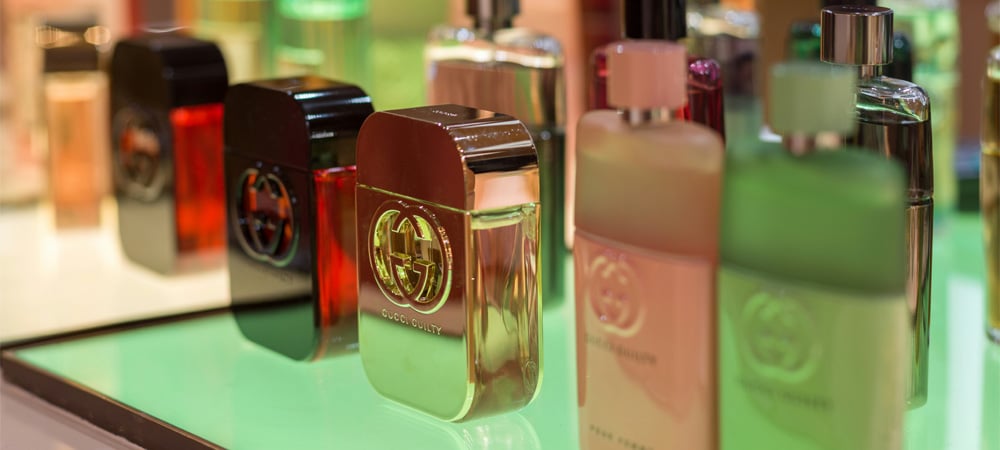Key Points
- Perfume Design that Sells
- Designing Your Perfume Fragrance
- Custom Perfume Bottle Design
- Perfume Packaging Design
- Marketing and Positioning Your Perfume Line
Article Summary
Successful perfume design requires thought, planning, strategy, and an understanding of the process from start to finish. From the perfect fragrance to custom perfume bottle design to marketing, we walk you through the steps to designing your perfume line.
How to Design Perfume to Sell
The perfume industry is thriving, worth $40.13 billion globally (and predicted to grow to 64.41 billion by 2030). But succeeding with a perfume line can be tough—the industry is competitive, and customers are more selective about quality and ingredients than ever.
Designing a perfume line requires attention to detail, strategy, time, and plenty of planning. From identifying your target audience to developing the perfect fragrance and establishing your brand, every step matters. Every element—from the scent itself to your branding and marketing—needs to work together.
How to Design a Perfume Line Step by Step
Follow this guide to understand the steps involved and learn how to design your own perfume line from start to finish.

Step 1: Get Clear on Your Goals and Your Brand
Before you can design a perfume line, you need to visualize what your goals are and who you are as a brand. You can’t just jump into creating a fragrance without considering the big picture.
Begin with the End in Mind
Spend some time thinking about what your goals are. Ask yourself:
- Why perfume? What is it that draws you to this industry?
- Where do you want to sell? High-end cosmetics shops? More general retail stores? Solely e-commerce?
- How do you visualize your brand? Specialty? Luxury? Casual? Sporty?
- Do you want to create multiple fragrances eventually? Or possibly expand to other products?
- What other perfumes do you want to emulate? And why?
You can’t always know where your brand will end up—you might pivot or change your goals later down the line. But getting clear from the beginning about the vision you have for your line and your brand will dictate everything from how you develop your fragrance to your perfume packaging design to your online presence.
Know Your Audience
Who do you plan to sell to? A playful scent for teens and young adults is entirely different from a fragrance for a more mature audience.


The original packaging for Pink by Victoria’s Secret looked like it was created for an older audience—and it didn’t align with the college-aged audience the loungewear line was popular with. We redesigned the packaging to create a younger, playful appeal that spoke to the target audience.
Think about who you want to appeal to. What are they looking for in a scent? Something professional and sophisticated? A date night scent with sex appeal? An everyday fragrance for work?
These perfume lines will look, smell, and feel completely different—and you want to know what you are creating before you begin.


We created a fun and playful perfume packaging and bottle design for Avon’s 50s Glam and 60s Pop line, while our designs for Aromadisiac were sexy and sensuous, created to represent the curvature of bodies.
If you’re not sure what your audience wants, market research is crucial. Find where your target customers hang out online and ask questions. Discover what people are looking for in their fragrances, what their lifestyles are like, and what they care most about (sustainability, ingredients, quality).
On the Entrepreneur Minds Speak podcast, PR expert Rich Small joined us to talk about brand strategy in the beauty industry. He recommended searching for hashtags on TikTok to uncover the latest beauty trends, along with tools like Spate to reveal upcoming industry trends.
Developing a fragrance takes time, testing, and money—the clearer you are on your audience upfront, the smoother the process will go (and the less money and time you’ll invest).
Research Your Competition
Once you have an idea of who you want to sell to, it’s time to take a closer look at the competition. What perfume lines are people in your audience buying and wearing? What is it about those brands and fragrances that appeal to them?
Competitor research isn’t just about the fragrance itself (although that is important). It’s about every brand element.
What are the bottles shaped like? What story is being told by these brands? What colors and imagery are they using? What is their packaging design like? Is it minimalistic? Are there trends that stand out to you?
What about their product copy and messaging? What language and tone are they using? Are they funny, uplifting, sensual?
Take notes about what you like (and don’t like). Determine what you can offer that isn’t out there—and how you can position yourself differently. Download our worksheet to get started!
Identify What Makes You Unique
One of the biggest mistakes you can make in perfume design is trying to appeal to too broad of an audience. Don’t be afraid to niche down and speak to a specific group of people.
Think about what you want to bring to the table that sets you apart. Do you want to offer a scent that’s completely unique? Or something more in line with popular options? Are there special ingredients you want to use? Are you committed to clean beauty? Do you have unique brand values that matter to you?
You don’t have to carve out every specific detail of your visual branding yet—but you do need to know what your brand stands for, what image you want to portray, and what emotions you want consumers to associate with your brand and your products. These details will pave the way as you start developing your perfume.
Step 2: Develop Your Perfume
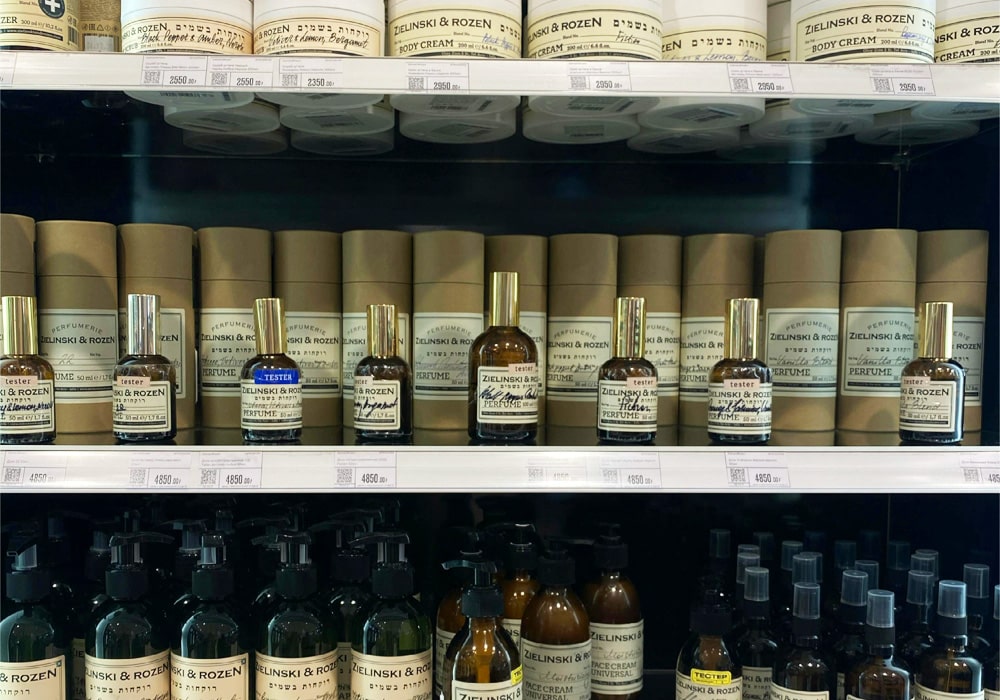
Perfume design is a complex process involving the fragrance itself, the bottle and label, and the perfume box or outer packaging.
How Are Perfumes Designed?
There are several components to developing and manufacturing a perfume line—and you want to understand the full process before you begin.
Perfume Development Methods
One of the first and most important decisions you’ll face is how to develop the perfume itself. There are two options—contract manufacturing and private label.
With contract manufacturing, you collaborate with a chemist to create a custom formulation based on your vision. This is more costly and time-consuming—but it also allows you to create a truly unique fragrance.
When you go with a private label option, you choose from existing formulations and pre-existing fragrances, then create your own packaging, branding, and marketing. You can often tweak the formulations to an extent, bringing in specific fragrances or adding ingredients, but they aren’t created uniquely for you or your brand.
The scent itself is the most important element of your perfume, but you’ll also want to consider the color of the product itself. Once you develop your branding and design your perfume bottle, you can have your manufacturer add color to the perfume to create the aesthetic you want. (An experienced perfume packaging design agency can also help you create a color to go with your branding.)
Understanding Fragrance and Notes
It’s important to understand what a fragrance consists of and what you want from your scent. Do you want your perfume to be sensual? Elegant? Woodsy? Remember your audience and your market research—you’ll need to create or choose something that resonates with the right customer base.
You need to think about the scent as a whole, but also the individual elements. Perfume is composed of layers of notes, each playing a role in how the scent is experienced.
The top notes are the first impression, evaporating quickly. The middle notes provide the heart of the fragrance, while the base notes linger longest, creating a lasting impression. Balancing these notes is key to creating a well-rounded scent.
Selecting or Creating the Fragrance
If you opt for a custom formulation, you’ll communicate with the manufacturer about your overall goals for your brand and your fragrance. Then, they will create a custom scent for you. The more unique your formulation is, the longer this process might take.
Perfume can’t just smell good—it also needs to be safe and be able to last on the shelf. Your formulator has to experiment with ingredients and scents to make this happen.
Whether you work with a custom formulator or choose a private label scent, your manufacturer should communicate to you about the notes involved. Don’t be afraid to ask questions, offer feedback, and ask to explore other options.
On the Entrepreneur Minds Speak Podcast, fragrance development expert Emilie Mascarell unpacked the process of creating fragrances for beauty products. She said that she recommends her clients take a few days to determine whether they like a fragrance she created instead of making a quick decision.
What might seem wonderful initially can feel off-putting after a while—and something that doesn’t jump out at you might grow on you throughout the day. Take the time to explore your fragrance and your options before making a final decision.
Locating the Right Manufacturer
Once you understand your options for perfume development and determine which path is right for you, you’ll need to find the right manufacturer.
Make sure you understand what your manufacturers offer. Some manufacturers offer turnkey solutions—formulating the fragrance, developing the bottle, and printing and labeling. Others might just handle one step of the process. Turnkey solutions are often easiest, but more expensive. Working with specialized vendors might be more affordable, but you’ll need to vet each vendor.
Our curated Manufacturing Guide offers a curated list of vendors for beauty & supplements, along with tips on how to choose the right fit. Online directories such as Thomas Net and Maker’s Row can also help you locate reliable vendors. If you’re working on a custom fragrance, The Chemist’s Corner has resources.
Don’t forget to carefully vet your manufacturers—make sure they are compliant with local regulations and industry standards. If you go with a company that isn’t credible, you might end up endangering customers and putting your brand at legal risk.
Step 3: Establish Your Branding Elements
Once you have an idea of what your fragrance is like, you’ll need to explore your branding. This will become foundational for both the primary packaging (the perfume bottle) and the secondary packaging (the box or container the bottle comes in).
You might also need social media designs, website design, and branded shipping materials—and you’ll need to decide what color your perfume itself will be.
These all have to work together to create a strong and memorable brand. If your branding is disjointed, it will be confusing and off-putting to your customers. That’s why developing your brand identity and strategy is important.
Here are the visual elements you’ll need to consider for all of your packaging and product design:
Color Psychology
The color of your fragrance, bottle, and secondary packaging all matter. Color changes the way we feel—and when it comes to branding that can make a big difference. In fact, color alone can influence 85% of consumer decision-making.
Black might evoke a powerful or masculine feel, while pink or red convey sensuality and romance. Blue brings in a sense of freshness, while green might bring up associations of nature or a woodsy feel.
Think about your scent and your audience. What emotions do you want them to feel? What colors might communicate those emotions?
Remember that your colors all need to work together—the bottle and the fragrance itself can both be colored, but think about how they will look cohesively.

The pops of gold against pastel colors in our packaging design for Dream Angels by Victoria Secret create an elegant, sophisticated feel.
Typography

While the average person might not realize it, the typography on a package also evokes certain emotions. Different fonts have subconscious psychological associations:
- Serif: Trustworthiness, credibility, formality
- Sans serif: Modern, straightforward
- Bold: Strong, powerful
- Light: Delicate, gentle
- Medium: Readable, clear, balanced
- Scripted: Elegant, vintage, creative, or happy
- Rounded: Warmth, softness
- Angular: Sharp, direct
You also need to make sure any copy on your bottle and secondary packaging is readable and that the most important information is positioned in larger text to command attention.
Remember that there are also specific requirements on font size—for example, your net weight will need to be a certain size based on the overall dimensions of your packaging, and all label copy must be legible.

In this design for Avon’s Outspoken by Fergie, we wanted to create a strong, expressive feel. The color palette was black and purple—regal and powerful. The imagery is mysterious, intriguing, and feminine. The flirty script font that pops on the black and purple and draws the eye immediately.
Graphic Design: Logos and Imagery
You want your perfume bottle to include your logo—a visual representation of your brand. A memorable perfume logo design can help you stand out and stick in the mind of your customers.
Think about your brand, your fragrance, and your audience. What imagery, icons, or visuals, can you incorporate to capture the essence of your brand and engage your audience?
Taglines, Messaging, and Product Copy
The product copy is also important. While your perfume bottle design likely won’t have room for any engaging copy, you can use your secondary packaging to tell your brand’s story and create the feeling you want to be associated with your brand.
Do you want your audience to be empowered? To feel fun and playful? Sexy and seductive? Create a catchy tagline and product copy that convey that message to your target customer.
Think of Your Designs Cohesively
Don’t forget that your branding elements aren’t just going to live on paper or a computer screen—they’re going to be part of your bottle design and your secondary packaging as well. You need to think about how everything works together in a 3D design.
This also means thinking about materials. For example, if your perfume bottle is textured, an attached label might not work. What looks good on a translucent package might not look good on an opaque one.
Will you create a color gradient? Do you want your bottle or label to be translucent? How much of the product inside do you want to see? You have to consider each element and how they work together.

For Avon’s Simple Elements, we created a minimalistic design with a lightly tinted fragrance in each bottle, reflecting the essence of each individual fragrance.
(If these elements feel overwhelming, we can help! Contact us to talk about designing your perfume line).
Step 4: Designing Your Perfume Bottle
The perfume bottle is often just as important as the scent itself. Your perfume bottle design can determine whether someone picks up your perfume over another option on the shelf, or stops scrolling to take a closer look at your photos online.
Designing a perfume bottle that aligns with the fragrance is crucial—they should come together to captivate your audience, evoke emotion, tell a story, and capture your brand identity.
Depending on your budget, you can opt for a stock option or create a custom perfume bottle design. If you can afford it, a custom perfume bottle design can make all the difference, positioning your brand as a premium or luxury option that truly stands out. (Explore our unique custom perfume bottle designs for ideas on different textures, shapes, and colors.)

We designed this custom perfume bottle for Hervé Léger Femme, creating visual interest, texture, and a captivating feminine look.
If you purchase a stock option, choose your bottle design carefully. Your manufacturer will offer different shapes, sizes, and colors. Ask for samples so you can explore what the bottle looks and feels like.
Who Designs Perfume Bottles?
Designing a unique perfume bottle takes not just creativity but also a deep understanding of branding, fragrance psychology, and how to tell a story. Many manufacturers can create custom bottles, but to create a captivating unique perfume bottle design, it’s best to work with an experienced design agency.
A great agency experienced in perfume bottle design can work directly with your manufacturer to develop a perfume bottle design tailored to your brand—one that captures the essence of your fragrance, commands attention, and speaks to your audience.
The texture of the bottle, the weight in your hand, the curvature, the color, the shape—every aspect of your perfume bottle design matters. It has to pique interest, engage the audience, and create the right atmosphere for your perfume.
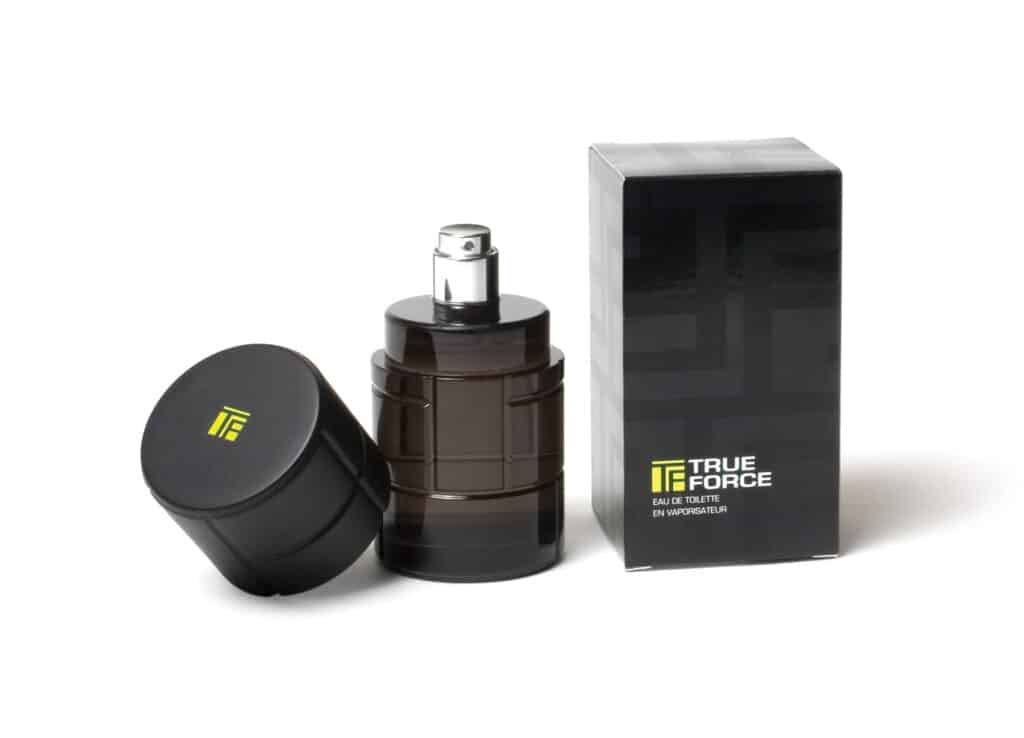
For Avon’s True Force, we designed a bottle with a heavy weight and robust texture, establishing a masculine, powerful atmosphere.
Crème de Mint’s founder spent years designing luxury perfume bottles at Victoria’s Secret and Avon. We’ve hand-mixed dyes, created personalized color gradients, and developed perfume bottle designs that evoke passion, romance, sensuality, and playfulness.

For Avon’s Slip Into, we created a custom unique perfume bottle design. The curvaceous bottle is shaped like the back of a stiletto heel, bringing a sexy, sensual feel.

Sometimes the tiniest detail of a custom perfume bottle design makes all the difference. For Avon’s Urban Edge, we designed a bottle without a cap, creating a unique, modern element.
Do You Need a Label for Your Perfume Bottle?
Many premium and high-end perfume brands choose to keep their perfume bottle design itself elegant and minimalistic, using a simple label on the bottom, along with secondary packaging, for the legal requirements and any other product copy.
They might opt to have no label at all, or a simple brand name, often printed directly onto the bottle, with a small sticker on the bottom containing any necessary information.
If you do decide to design a separate label, you’ll need to make sure it conveys a quality feel, especially if you’re marketing to a high-end audience.
Don’t Forget the Red Tape
In 2022, the MoCRA Act passed to protect consumers and ensure safety of cosmetic products. Part of this act also included FDA requirements for product labeling.
Your perfume bottle itself needs to include an identity statement describing the product, such as eau de parfum along with the net weight. Typically a small label on the bottom of the bottle will have the net weight, the name of the fragrance, distribution statement, flammable warning symbol, and period after opening (PAO) symbol. Additional information, such as ingredients and fragrance allergens, warning labels you might need based on your ingredients, will be on your secondary packaging.
Make sure you understand legal requirements for all parts of your packaging to avoid putting your business at risk. (For more help ensuring your brand is compliant, listen to our podcast episode on the topic).
Step 5: Designing Your Secondary Perfume Packaging
In addition to your fragrance, bottle, and label, you’ll also need to create secondary packaging—the box your perfume bottles comes in.
Your perfume box design is important, especially if you plan to sell retail. Your branding elements—from your logo to your colors—will need to make sense as a whole.
That doesn’t mean your box should appear identical to your bottle—it just means that it needs to work cohesively and complement your bottle and your fragrance.

In this design for Avon’s Brazil Beat, we created complementary packaging that carried through from the bottle to the box, with vivid colors and a tropical feel.
DIY and AI vs. Hiring a Perfume Packaging Design Agency
Launching a business takes capital—and you might be tempted to save money by designing your own packaging or using AI rather than working with a packaging design agency. It’s important to understand the pros and cons of your options to decide what’s best for your brand.
DIY Templates:
Pros:
Short-term savings—a low upfront cost can be appealing for new brands.
Quick turnaround—with plug-and-play options, you can have a complete design in just a few hours.
Cons:
Limited customization options—you can make changes with a template, but only to an extent. This makes it difficult to create branding or packaging that is unique to you, which could prevent you from standing out. It also makes it easier for other brands to copycat your design.
Lack of cohesive branding—when your designs aren’t created based on template options and not through intentional branding strategy, your overall brand could suffer. Branding and design agencies approach everything cohesively, creating a strong brand story and identity.
Compliance risk—if you create your own label and packaging, you also run the risk of violating FDA regulations, setting yourself up for legal risk.

This is an example of what you can expect through a packaging design template. You can find stock templates in specific colors—but there will be little in the designs that reflect your unique brand.
AI
Pros:
Cost—AI options are either free or minimal cost, typically cheaper than templates.
Speed—Like templates, AI offers convenience and speed. Some AI generators can design a logo or label in a matter of moments.
More customization than a template—AI is also capable of generating more unique elements, offering you more creative and customization options.
Cons:
Lack of creativity—AI generates—it doesn’t create. Designs made by AI aren’t built on emotion or the human element. This can lead to packaging that doesn’t resonate with your customers.
Lack of cohesive branding—AI designs individual elements, not cohesive, strategic branding.
Ownership rights—the United States Copyright Office has ruled that images or artwork created by AI are not eligible for copyright. Instead of owning your business assets, the ownership rights belong to the platform producing the design—which means they can repurpose and use the images as they see fit.
Compliance risk—just like with a template, if you use AI, you run the risk of misunderstanding FDA regulations and creating non-compliant labels. (For more help ensuring your brand is compliant, listen to our podcast episode on the topic).
Working with an Agency:
Pros:
Industry expertise—Working with an experienced cosmetic packaging agency means you are tapping into industry expertise and gaining valuable guidance and insight.
Compliance and claim understanding—Cosmetic packaging design agencies understand the latest compliance regulations and legal requirements, and can help you avoid non-compliance.
Unique, custom design built on your brand—Designs created through a cosmetic packaging agency are strategically created based on you, your brand values, and your target audience. They are truly unique to your brand.
Cons:
Cost—branding, perfume bottle design, and packaging design are expensive services. It can be hard to make the investment early on.
Turnaround time—quality agencies create branding based on research, strategy, and cohesive branding—all of which do take time. This will likely take 6 weeks or more depending on how quickly you make decisions and provide feedback.

In this design for Victoria’s Secret Insatiable, we custom designed a gift box reminiscent of a high-end chocolate box, creating the sense of indulgence and luxury. This attention to detail and strategic design comes from an experienced agency—not a stock template.
Step 6: Determine Your Product Price Point
Investing in a product launch takes money—and you need to make sure you’re profitable. That means setting the right price for your perfume.
If you price too high, you might not be able to sell your product. But if you price too low, you might convey a cheap feeling and miss out on appealing to your audience. You might also price yourself in a way that doesn’t lead to profit.
Consider all of these elements when setting your price point:
Competitor Pricing
What is the going rate for perfume in your niche? Do you offer something special—such as higher quality of ingredients?
It’s tempting to try to be the lowest option—but this can backfire. Try to align your pricing with your competitors, but make sure you are charging for premium elements, such as organic ingredients.
Understand Your Cost Per Unit
Next, calculate your cost per unit by adding together all production-related expenses. This includes the cost of materials, packaging, labor, manufacturing, and shipping. Use the following formula to determine your unit cost:
(Cost of production + Cost of packaging + Shipping costs + Labor) / Number of Units = Cost per unit
From there, you’ll need to mark up the price of your perfume to maintain a profit and align with the market.
To simplify these calculations, use our free product pricing worksheet, which can guide you through setting a price point that aligns with your cost objectives and profit goals. (For more support on the details of your product launch, Our course, Launch My Beauty Product, can offer more support on your product launch).
Step 7: Marketing and Selling Your Perfume Line
Once your perfume line is ready, the next step is getting it in front of customers. Marketing, positioning, and selling are critical. You might have the best perfume in the world, but if you can’t sell it, you can’t sustain your business.
Working with Retailers
Selling your perfume wholesale to retailers allows you to scale your distribution and reach a broader customer base. To find the right retailers, reach out to specialty stores that align with your brand, or partner cosmetic distributors, like L&R Distributors who can help connect you with larger stores.
Trade shows and expos are another way to connect with retailers and find a place for your perfume line. Building strong relationships with these retailers is key to spreading awareness and attracting new customers for your perfume line.
Creating branded materials, such as booths, tablecloths, and banners can help you gain attention and start forming those relationships. Having these materials professionally designed can help make sure you are establishing a strong, cohesive, eye-catching brand.
Building a Web Presence
You also want to build a strong web presence for your perfume line. Build a strong social media presence and start interacting with your audience. Remember that customers need to see your brand several times before making a purchase—so the more you can get in front of your audience, the better.
A strategic website design can strengthen your brand and build customer loyalty. Your website should reflect your brand’s identity and offer an easy, enjoyable shopping experience. Consider expanding your reach by setting up an Amazon store, where millions of potential customers can discover your fragrance.
Partnering with Influencers
Influencer marketing is a strong way to get your perfume line in front of potential customers. Consider working with beauty influencers who can promote your product on social media.
Building strong, genuine relationships with influencers you want to partner with is a great place to start. (For more tips on promoting your product and securing influencer partnerships, listen to our Entrepreneur Minds Speak episodes on social media marketing and PR strategies for beauty startups.)
Leading Your Line to Success
Launching a perfume line is just the beginning. To lead your line to success, you must continuously test your products with consumers and be willing to iterate based on feedback.
Our goal is to help you succeed—here are some episodes of our podcast that can support you on your journey and spark ideas on your product launch:
EPISODE 20: Social Spark – Igniting Your Product Launch!

EPISODE 32: Creating a Scent for Your Product with Product Development Expert Emilie Mascarell
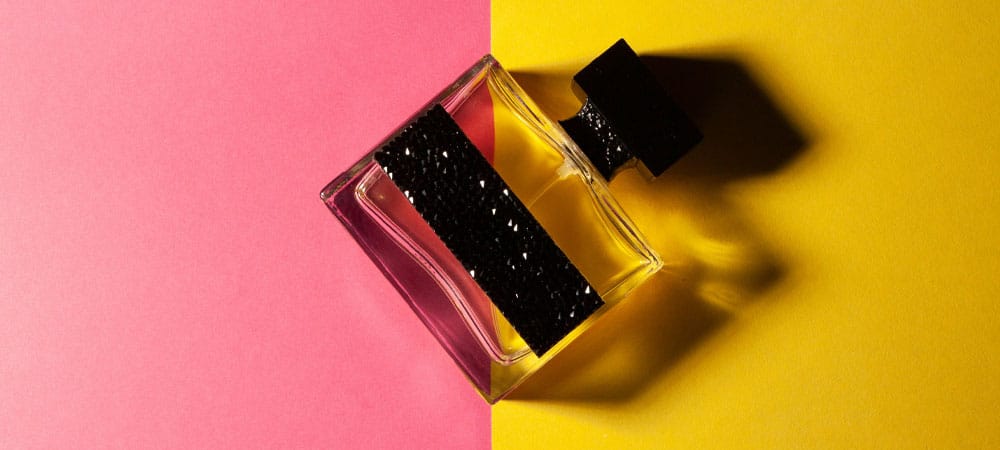
EPISODE 28: PR Strategies for New Beauty Brands with PR Expert Rich Small
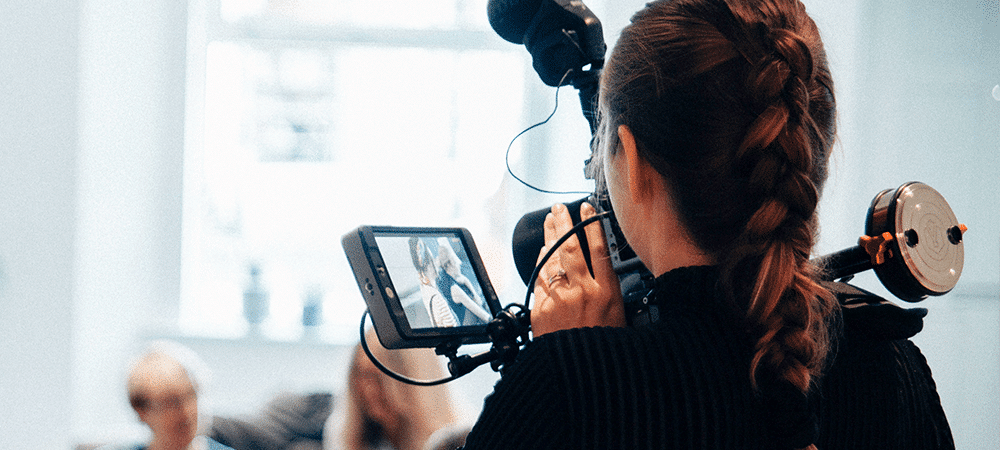
Remember that building a successful perfume brand takes time and dedication. It’s not going to happen overnight. But with the right branding strategy, ongoing marketing, and persistence, you can continue to grow your brand. (Our course, Launch My Beauty Product, can offer more support on your product launch).
Ready to partner with an experienced branding agency? Contact us to talk about how to design your perfume line today!


